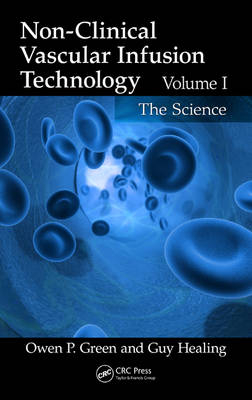
Non-Clinical Vascular Infusion Technology, Volume I
Crc Press Inc (Verlag)
978-1-4398-7449-3 (ISBN)
Non-Clinical Vascular Infusion Technology, Volume I: The Science covers the scientific principles behind the delivery systems, from both physical and physiological standpoints. The book addresses body fluid dynamics, describes the scientific processes necessary to understand the various aspects of the physico-chemical issues relating to vascular infusion delivery, and discusses vascular infusion dynamics. It also considers all the essential elements of the preparation of a formulation intended for vascular delivery as well as assessment of compatibility of the formulation with the dosing apparatus. This volume, along with Volume II: The Techniques, provides a foundation of knowledge on infusion technology and its importance for safe clinical use of substances via this route of delivery.
Features
Identifies and shares best practices for non-clinical vascular infusion
Presents modern practices and procedures in line with up-to-date equipment development
Offers recommendations for in-life assessments in order to monitor the success or problems with the vascular infusion delivery
Makes comparisons with human data in many areas
Owen Green is a toxicologist who has spent nearly 40 years in the preclinical toxicology industry within leading global CROs or as an independent consultant in toxicology to pharmaceutical and chemical sectors. Following his masters degree in pharmacological biochemistry and Ph.D. studying chronic renal disease, he has spent many years working with and studying the practice of infusion technology in non-clinical toxicology programmes. He is one of the founders and current chairman of the Infusion Technology Organisation. This is an international group set up to share commercial and academic experiences with the technology in order to improve the techniques and scientific understanding for the benefit of the animal models involved and to improve the scientific quality of the data generated. Guy Healing is an experienced regulatory toxicologist who has worked in pre-clinical pharmaceutical R&D for nearly 20 years, and prior to that in agrochemical R&D and for a global CRO. He obtained a BSc in biochemistry at Cardiff University and his Ph.D. investigating the role of iron and oxygen-derived free radicals in the pathogenesis of renal ischaemic damage while working for the Medical Research Council. Guy is a Fellow of the British Toxicology Society and has been editor of its newsletter as well as a member of the Executive Committee. He has published previously in the area of infusion technology, including the Handbook of Pre-clinical Continuous Intravenous Infusion in 2000.
Body Fluid Dynamics. Introduction. Composition and units of measurement. Compartmentalization and Distribution. Movement between Compartments/Exchange. Body Fluid Homeostasis. Summary. References. Physico-Chemical Factors. Introduction. Osmolality. Acid-Base Balance. Viscosity. Surface Tension. Diffusion. Summary of Infusion Forces. References. Vascular Infusion Dynamics. Essential physiology. Intravenous Delivery Rates and Volumes. References. Formulation Considerations. Introduction. Formulation selection strategy. Study design and species/strain. The properties of the compound. Strategies for dealing with poor solubility. Unwanted formulation effects. Excipient toxicity. Strategies for dealing with injection site reactions and haemolysis. Strategies for dealing with poor stability. Sterility. Conclusion. References. Prestudy analytical assessments: Equipment compatibility. Stability of the formulation with the formulation storage vessel. Compatibility. Choice of material. References. Haemocompatibility. Introduction. Objectives. Methods of assessing haemocompatibility. Discussion. Conclusion. References. Annex: Common excipients and vehicles.
| Zusatzinfo | 48 Tables, black and white; 15 Illustrations, color; 28 Illustrations, black and white |
|---|---|
| Verlagsort | Bosa Roca |
| Sprache | englisch |
| Maße | 156 x 234 mm |
| Gewicht | 498 g |
| Themenwelt | Studium ► 2. Studienabschnitt (Klinik) ► Pharmakologie / Toxikologie |
| Naturwissenschaften ► Biologie ► Biochemie | |
| Naturwissenschaften ► Biologie ► Zoologie | |
| Veterinärmedizin | |
| ISBN-10 | 1-4398-7449-2 / 1439874492 |
| ISBN-13 | 978-1-4398-7449-3 / 9781439874493 |
| Zustand | Neuware |
| Haben Sie eine Frage zum Produkt? |
aus dem Bereich


